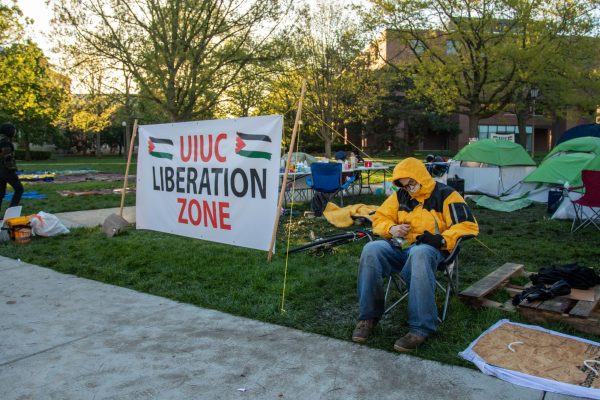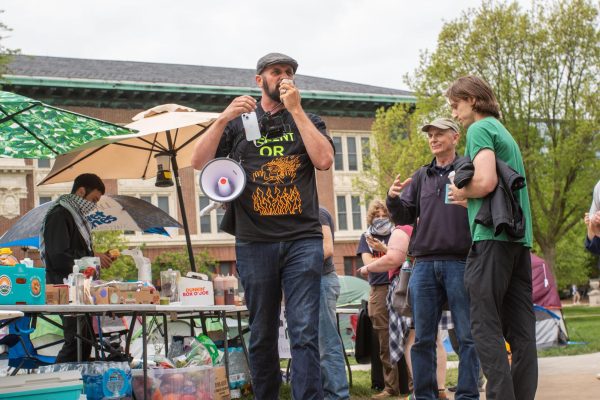Small-town students face “deep-rooted” obstacles to come to University
Sondra Monier (left) sits with her two sisters, Jillian (middle) and Hannah, at the Marshall-Putnam Country Fair in July 2012. Monier came from Sparland, Ill., a small-town population of 396 that she feels gives her a unique perspective at the University.
April 8, 2014
Sam Dewey and Olivia Foor, seniors in LAS, see stars in the night sky differently than people from big cities at the University. They reminisce about how bright the stars are in the country versus how faded they look under the micro-urban lights on campus.
Dewey and Foor said they met when they lived on the same floor in Scott Hall during their freshman year, but their friendship was sealed through their small-town connection.
“I think that’s one of those instant connections and why Dewey and I are such good friends still,” Foor said.
It is friendships like these that the Morrill Land-Grant Acts of 1862 aimed to foster. 2012 was the 150th anniversary of the land grant that established the University. This celebration reminded the campus that the grant expanded “access to higher education beyond the privileged few” in Illinois to less wealthy citizens.
Dewey is from Germantown Hills, Ill., which has a population of almost 3,500 people. Foor is from Tower Hill, Ill., with a population of about 600 people. They both attended feeder high schools — larger high schools in neighboring cities that took in small-town students. Still, Foor said there were only about 110 people in her graduating class.
Get The Daily Illini in your inbox!
Lanae Ringler, junior in ACES, and Sondra Monier, senior in ACES, formed a similar bond. Monier is from Sparland, Ill., where she said there is only one stoplight in the county.
“If you didn’t know how to change a spare tire, drive a tractor or combine, you were the minority,” Monier said.
It is “critical societal needs” programs, such as agriculture and mechanical arts, that the grant also encouraged.
“I think that rural students have a unique story to share with others that did not grow up in a similar community, as do students who did not grow up in a rural community with us,” Monier said.
Even so, The News-Gazette reported in late March that the population of University rural students, all from “noncore” counties in Illinois, has shrunk 42.7 percent from 1993 to the 2013-2014 school year. Dewey and Foor echo the same remark.
Because of the close connections in small towns, Dewey and Foor said they realize it is difficult for many to leave home. When Foor goes to a gas station in Tower Hill, she knows everyone there by name.
“A lot of kids don’t have any desire to get out past the edge of their county,” Foor said.
Before leaving Tower Hill to come to the University, Foor did not know what an Advanced Placement class or test was because they were not offered at her high school. Dewey said his high school only offered two AP classes.
Dewey and Foor noticed that students who come to the University with AP credit get ahead in class registration, giving them more opportunities than rural students who do not.
“That was really frustrating coming in and seeing so many people on my floor were literally a year or two ahead of me, and I don’t feel there was anything I could’ve done personally. It was just geographic, so that’s frustrating,” Dewey said.
Money is another issue that affects rural students. Foor said she cannot think of 10 people that could afford to come to the University. These students said that many rural students from their hometowns go to junior colleges instead of big universities because small towns direct more scholarships toward the junior colleges.
Dewey will be the first in his family to earn a bachelor’s degree. Still, every May, he contemplates whether he can afford to return to the University.
Dewey and Foor commend the University for recognizing the need to recruit more rural students, but they said they think recruiting is not necessarily the first step.
“Although we think it’s a good effort by the University of Illinois to recruit from downstate schools, we think it would be more effective to help the downstate students who are already here,” Dewey said.
Dewey and Foor said they believe one way to assist is through financial-need scholarships, which would benefit rural students who cannot afford to go to the University. They said they think that would help rural students who are disadvantaged in academic scholarships compared with Chicago suburb students.
Dewey and Foor said their biggest fear is that they will have to return home after college. In the eyes of a small-town community, Dewey said moving home after going away to a big university means you “failed.”
Ultimately, Dewey and Foor are proud of attending the University. According to Foor, succeeding at the University after coming from a small town “makes success a lot more gratifying.”
Rebecca can be reached at [email protected].







